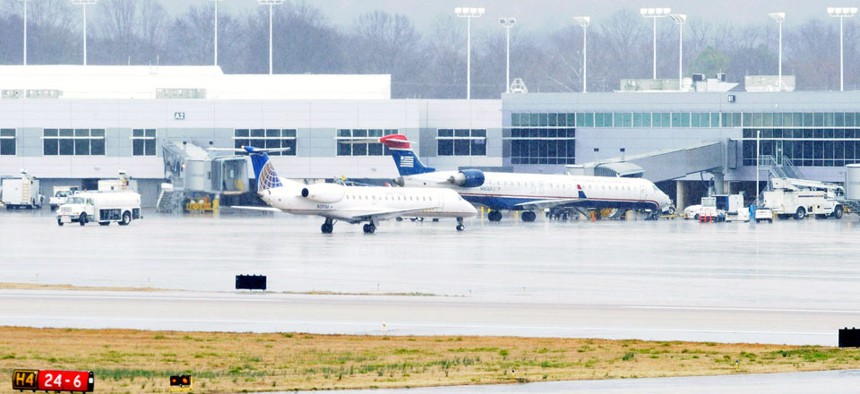
A United Express jet operated by ExpressJet pulls into the terminal after landing in rain on the main runway at Birmingham-Shuttlesworth International Airport. Jay Reeves/AP
NTSB Reveals Two Near Midair Plane Collisions in Two Days
In one of the incidents, planes were flying at heights assigned by air traffic control.
The National Transportation Safety Board (NTSB) revealed this week that on two separate occasions last month, passenger planes nearly collided in midair in U.S. airspace. Which is two times too many, as far as we're concerned.
The first incident occurred near Newark on April 24. The AP reports that according to the NTSB report, a United flight heading to the airport from San Francisco narrowly passed an outgoing ExpressJet flight heading towards Memphis. There was only about 200 feet laterally, and 400 feet vertically dividing the two planes — far less than the usual minimum two miles between passing flights. The NTSB report indicates that timing mishaps led to the near-accident:
An air traffic controller waited for another plane to land on the east-west runway, then cleared the ExpressJet to take off heading north. At that point, the United flight was about three miles away. By the time the ExpressJet flight started its takeoff roll, the United flight was about one mile away. As the two planes approached each other, the United flight was ordered by the tower to abort its landing and go back up. The ExpressJet pilot can be heard on radio telling air traffic controllers he was keeping the plane's nose down as he climbed. At one point he tells the tower the United flight came "real close" to him.
CBS New York reports that, according to sources, the United pilot was ordered to circle the airport but did not do so, instead opting to land the plane. That flight was carrying 155 passengers and six crew members, and the ExpressJet flight had 47 passengers and three crew members on board.
The second incident took place one day later, north of Hawaii. Disturbingly, both those flights were flying at heights assigned them by air traffic control, NTSB representatives told CNN. The incident is still under investigation, but it was clear to those on board that something had gone terribly wrong. In a blog post that brought the event to national attention, passenger Kevin Townsend described what it felt like on board one of the planes, heading from Hawaii to LAX, when it dropped 600 feet in less than a minute.
Thirty-three thousand feet up in a cloudless sky, our plane had suddenly pitched into a steep dive. I felt my body float upwards and strain against my seatbelt. Passengers around me screamed. There was a loud crash in the back — a coffeepot clattering to the floor and tumbling down the aisle... The voice of an audibly flustered flight attendant came over the speaker. “OK. That was obviously unexpected.” An understatement. The fasten-seat-belt sign was still off. A moment later, after we’d laughed and settled back into the friendly fiction of air travel as a mundane commute, her voice returned to notify us that “the pilot took evasive action to avoid an aircraft in our flight path.
CNN has more technical details on the incident, as well:
United Airlines Flight 1205, which was headed east to Los Angeles from Kona International Airport on the Big Island of Hawaii, had to descend quickly to avoid a westbound US Airways jet, approximately 200 miles northeast of Kona. The United pilots received an audible warning that the plane was in danger from its traffic collision avoidance system, which monitors airspace around a plane. Both planes were Boeing 757s.
Had two fully loaded Boeing 757s collided over the Pacific Ocean, it almost certainly would have been the deadliest air disaster in history.
CBS reported last week that the event was blamed on errors on the ground — mainly, an air traffic controller working in Honolulu failed to realize that the planes were headed towards a collision. Still, former head of the NTSB Mark Rosenker told CBS News that the traffic collision avoidance system "gave the appropriate instructions to both pilots," adding that human error was unavoidable but the technology successfully prevented a disaster. "We have seen a significant reduction in mid-air collisions since we have adopted these programs and this technology on-board commercial aircraft," said Rosenker. Forgive us if we think that two close calls in two days isn't the most comforting example of aviation safety in action.






